Height conqueror
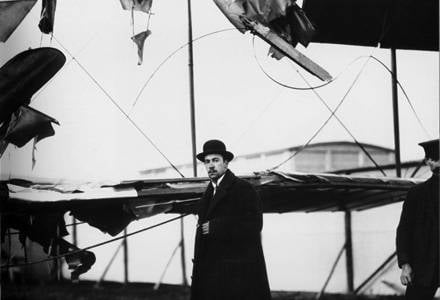
The Sikorsky family was not only known in Kiev, it was highly respected. The head of the venerable family, who chose one of the most mysterious areas of medicine - psychiatry and the treatment of mental diseases as his field - had already gained worldwide fame, becoming a recognized authority in this field. His works were translated into European languages, discussed at international congresses, and books on the upbringing of children endured more than one publication abroad and were used as textbooks in many countries.
Zinaida Sikorskaya, nee Princess Temryuk-Cherkasskaya, also received a medical education. But, as they would say today, she didn’t work a day in her specialty, devoting herself entirely to the family and raising children - Lydia, Olga, Elena, Sergey and Igor. She instilled in them a love of literature, music, stories - the fact that she loved herself.
It was she who told little Igor about the great Italian thinker of the 15th century, Leonardo da Vinci and one of his brilliant insights, never realized, an aircraft that could fly into the air straight from the spot without a run-up.
This mother's story crashed into a child's memory. The dream to build such a car grew and strengthened with the boy. Believe it or not, believe it or not, but having read a vague description of the helicopter in one of science fiction writer Jules Verne’s novel Igor Sikorsky had already made a model of an unseen car at the age of eleven. Wooden, with a rubber engine, it ... no, did not rise into the air, but only galloped, like a stubborn foal, across the lawn of the house. But the young designer is not confused. As they say, the first step is the hardest.
In 1903, Igor entered the St. Petersburg Naval Cadet Corps. As the program disciplines were mastered, the midshipman Sikorsky’s craving for technology became more and more apparent. He studied with pleasure, but he understood more and more clearly that his military career was not for him.
Somehow, Sikorsky came across several short newspaper reports about the Wright brothers' flights. And he again began to rave the sky. The dream to create flying cars did not go out of my head. But where to learn this? After all, educational institutions of such a profile did not exist in Russia at that time. And in the 1906 year, after graduating from the general course, Igor, despite the categorical disapproval of parents, decided to leave the Cadet Corps. He leaves for France and enters the technical school of Duvigno de Lanno. After studying there for six months, Sikorsky returns to his homeland and in the fall of 1907, he enters the Kiev Polytechnic Institute.
It has been a year of study. The young inventor spent all his free time in an improvised home workshop. A few months later, as if in passing, along with other technical research, he built a steam bike, which resulted in astonishment of others. But Igor wanted something more.
In 1908, he went to Germany with his father on vacation. There he comes across a newspaper article with a detailed description of one of the Wright brothers' flights. This message shocked Igor. The possibility of creating a flying machine - the centuries-old dream of mankind! He wholeheartedly felt that aviation - it is a matter of his life. But what is most surprising, the airplanes that barely got on the wing seem to him already uninteresting. And Sikorsky - at nineteen! - decides to take up the creation of an apparatus that could take off and land without a start, hang motionless in the air and move in any chosen direction. This idea captivates the young man so much that he, without delaying his affairs in a long drawer, draws the first drawing of a helicopter right in the hotel - an air machine that exists only in his imagination so far ...
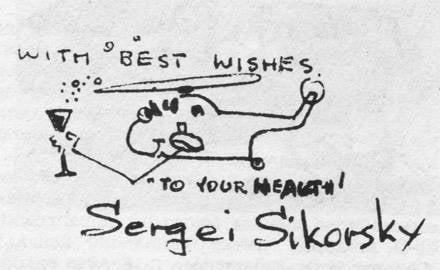
Thorny paths of pioneers
Returning home after the holidays, Igor continued to work in his home workshop. At the same time, he reads about aviation everything he could get, and by the end of the year he already knows almost everything about world aviation experience.
Knowledge was required to translate into practical work. But for the construction of a full-scale helicopter needed money. Those small funds that were in the personal possession of the young Sikorsky, were spent for a long time for research. Moreover, the practical work so fascinated the designer that he almost abandoned the institute, appearing in the classroom from time to time. The teachers complained to the father about the unsuccessful, in their opinion, son and asked to take action. However, Ivan Alekseevich saw in the hobbies of his son not an empty youthful fun.
Taking advantage of the parent's favor, Igor gathered the family council and, having told about his plans, asked for material assistance. In order to continue his work, he needs to go to Paris, gain knowledge and experience, and most importantly, purchase an engine and other necessary materials to create a model, not a model, but an operating rotary-wing machine capable of taking off the ground. And although the opinions of relatives were divided, Igor received the necessary funds and, equally important, the blessing of his father for further technical research. And in January, 1909 left Kiev.
In Paris, he visited the airfields of Issy-les-Moulineaux and Juvisy on a daily basis, greedily perceiving everything that happened. And there was something to see! Even flight attempts made a deep impression on the young man. There was a lot of a variety of designs, which were the fruit of ingenious, half-crazed or completely insane ideas of the inventors. Many devices could not even get under way. If the car ran across the field, bouncing, it was already promising. In the event of an accident, if she did not kill the pilot, it was considered quite suitable. There was a beautiful, open and honest struggle of ideas, embodied in these fragile mechanisms that promised humanity a new stage in its development and exploration of the planet.
In Paris, Sikorsky met one of the pioneers of world aviation, Ferdinand Ferber. Constructor and test pilot in one person, Ferber accepted the young man, listened to him carefully and ... advised not to waste time on the helicopter, but to concentrate on the airplane as a more promising machine and supplied the young inventor with the necessary literature. But at the same time he offered the young man to take a course in the school of pilots he had recently organized.
It is clear that Sikorsky gratefully accepted the offer of the master. He combined his classes with informal communication with Ferber who favored him. Once between the student and the teacher there was a conversation about aircraft engines:
- Which one is the best and reliable? - asked Sikorsky.
“Neither the best nor the good engines are now there,” was the Frenchman’s response. Then Igor in another way formulated the question:
- Which one is the least bad?
“Look at the Anzani engine ...”
It was with this engine, bought in France, that Sikorsky returned to Kyiv in May 1909, where he recognized two news. One of the European newspapers reported that the French pilot Louis Bleriot flew over the English Channel on his airplane with the engine of Alexander Anzani, overcoming the inconceivable 40 kilometers in those times. Another placed a short note about the death of the pilot and aircraft designer Ferdinand Ferber during the flight ...
It would be fair to say that by the summer of 1909, mankind already knew something about airplanes, but still nothing about helicopters. The student of the Kiev Polytechnic Igor Sikorsky was at that time, if not the only, then certainly one of the few enthusiastic designers involved in rotary-wing machines.
He worked tirelessly, not knowing sleep and rest. And in July, 1909-th construction of the existing model of the world's first helicopter was completed. Starting to test his car, the inventor set modest goals - to check the operation of all mechanisms and evaluate the magnitude of the lifting force.
Alas, it was not enough to tear the car off the ground. It was required, with the existing engine power, to lighten the weight of the structure itself and to seriously improve the rotors. Sikorsky feels that he lacks neither engineering nor theoretical knowledge, and in the fall he goes to Paris again to get acquainted with the novelties of rapidly developing aviation.
This time, he manages to witness not a series of attempts to tear off winged cars from the ground, but real flights. Including - the historic flight of Count de Lambert, who was 18 October 1909 of the year, taking off on the Wright brothers' apparatus from the airfield of Juvisi, sailed over the French capital at an altitude of 400 m, flew around the Eiffel Tower and returned safely to the launch site. Impressed by what he saw, Sikorsky, without abandoning ideas for creating a helicopter, decides to build an airplane of his own design and fly it into the air. He wants to fly!
Igor returns to Kiev with two new, more powerful Anzani engines. And proceeds to build ... snowmobiles. Hitherto unseen neither in Russia nor in the world did Sikorsky need a car for fun. While the first airplane and the second helicopter were being assembled in the hangars, the designer decided to test the engines in all modes, propellers of various designs and from different materials on the snowmobile and, equally important, gain practical experience in controlling the machine propelled by the propeller.
Throughout the winter, Sikorsky, causing amazement among the townspeople and delight among the boys, rolled passengers along the snow-covered streets of Kiev. Only at the beginning of March both engines were dismantled from snowmobiles and installed on aircrafts. The first Igor decided to try his favorite offspring.
And in the early spring of 1910, a miracle happened in Russia that was unappreciated by anyone: for the first time in the world, a car with two rotors — a helicopter that could lift its own weight in 180 kilograms — broke off the ground ...
Alas, as long as it was the limit of his capabilities: even the new apparatus did not have enough silences to board the pilot, let alone passengers or payload. Igor realized that in the near future he would not succeed in building a full-fledged car capable of “rising without a run and floating in the air in one place without horizontal speed,” there is not enough developed theory, there are practically no experimental data. And the designer completely switched to creating airplanes, especially since the construction of the first machine of his own design was already nearing its end ...
"We learn to fly planes ..."
PLANE C-1, which at the end of April 1910 volunteer assistants of Sikorsky rolled out of the shed, which was loudly called the hangar, onto a lawn on the outskirts of Kiev, was a two-post biplane. A fifteen-power Anzani engine with a pusher propeller was mounted on the lower wing behind the seat. The elevator was controlled using the handle located to the right of the pilot, the aileron was controlled by the handle to the left of the pilot, the rudder was controlled by the pedals ...
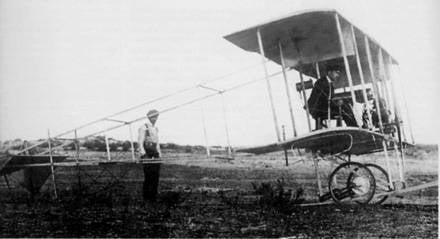
For three weeks Igor Ivanovich tried in vain to raise his brainchild into the air. Inexperienced pilot could not manage to catch the desired angle of attack. The device, stumbled upon an imperfect chassis - ordinary wheels from a bicycle! - on the bumps and falling into the pits, all the time I strove to turn around during the run. Engine power is clearly not enough. One day, the pilot managed to get half a meter off the ground, but this happened only due to a strong gust of wind. In addition, the gap was so short-lived that Sikorsky could not even try the rudders ... In general, the C-1 was born "stillborn."
2 June 1910, the C-2 was prepared for the first flight. On him, Sikorsky put the engine power 25 l. s., taken from a helicopter. And he installed it in front, taking into account the experience of plane crashes that was already rich by that time: during any serious accident, the engine fell from the bindings and fell with all its weight on the pilot.
The morning of the next day was quiet and cloudless in Kiev. There was a breeze. C-2 rolled out of the angara. Igor Ivanovich took the place of the pilot. He warmed up the engine, squeezed the maximum gas. Three people barely held by the tail and wings of a car tearing into the sky. On command, they let go of the airplane. There were no instruments on board; Sikorsky made up the idea of speed by the oncoming air flow. This time it was significantly higher than during previous attempts to take off. And the pilot smoothly pulled the elevator handle ... The sports commissars of the Kiev Society of Aeronautics, who were invited by Sikorsky absolutely confident of success that day, recorded: the flight range was 200 meters, the duration was 12 seconds, the height was 1,5 meters. It was the third domestic airplane flight in Russia.
After completing two more successful flights in a straight line and feeling very confident in the air, Sikorsky decided to make his first flight in a circle. To fulfill our plans, it was necessary to fly over a deep ravine, turn around over the field, cross the stream and return to the starting place.
30 June afternoon Sikorsky lifted the car into the air, easily gained a height of about seven (!) Meters, crossed the field and began to turn toward the ravine on its border. The jet from the propeller, along with the smoke from the burnt castorca and drops of oil, hit the face, the hands felt the elasticity of the steering wheels of the obedient machine. All this gave birth in Igor Ivanovich’s soul a delight and a feeling of happiness: he drove an airplane of his own design above the ground! ..
And he did not immediately notice that the swamp located at the bottom of the ravine began to move swiftly. The next moment there was a crash: C-2 hit the slope, the pilot flew out of the cockpit and was covered with a crashed vehicle. Fortunately, not far were friends. Even before takeoff, they came to the edge of the ravine to see the first turn closer, and now they were witnesses to the accident. To their surprise, the tester was safe and sound, except for bruises and scratches. The plane together with the engine was completely broken and could not be restored.
Failure did not cool Sikorsky's ardor. He spent a long time and thoroughly - both as a designer and as a test pilot - he analyzed the causes of the first accident that happened to him and the apparatus of his design. And he came to the conclusion that the C-2, even at maximum engine speeds, could barely stay in the air during simple horizontal flight. The turn demanded a reserve of power, which was not. The situation was aggravated by a ravine with a cold swamp on the bottom, above which an air hole was formed. A set of these adverse factors and played a fatal role.
C-2 no longer existed. He summarily stayed in the air for less than 8 minutes, but this time was quite enough for the pilot and designer Sikorsky to receive a large amount of new information, which can now be used to calculate, build, and pilot future aircraft.
During July, Sikorsky made blueprints for the new car and 1 August went to Paris for the engine. This time he purchased the Anzani forty-strong motor. By the time Igor Ivanovich returned to Kiev, his assistants were finishing the assembly of the airplane. The end of October and the whole of November were spent on debugging and adjusting the car, taxiing and jogging. In early December, the C-3 performed the first flight in a straight line. The plane was undoubtedly more perfect than the previous ones: it took off easily, responded well to the actions of the controls, had a power reserve. On it, Sikorsky for the first time rose to a height of more than 15 meters ... 13 December 1910 of the year, while trying to fly in a circle, the plane crashed onto the ice of a frozen pond, almost burying its creator under the rubble.
It was why despair. But barely recovering from swimming in the December polynya, Igor Ivanovich makes a plan for further work: in the spring he intends to lift C-4 and C-5 into the air. And if the first was, in fact, a copy of the crashed C-3, then C-5 was originally conceived by the designer as a new step in aircraft construction.
First, the steering wheel first appeared on it. Secondly, a somewhat heavy, but more reliable Argus engine was used, which had water cooling and power in 50 l. with. Thirdly, Sikorsky changed the configuration and internal design of the wing, and also for the first time applied a special treatment for the skin, which significantly improved the aerodynamic qualities of the airplane. Fourth, on the C-5 - the first of the aircraft - there was an additional fuel tank and the ability to switch to it right in the air. And, fifthly, also for the first time in aircraft construction, a second seat was located on the car!
At the end of April 1911, the flight tests of the C-5 began, starting with which Sikorsky tried to take into account his entire experience of fifteen minutes in the air and two falls. Igor Ivanovich had no other sources of knowledge on piloting at that time.
After several test runs from the ground, the Sikorsky 17 of May made the first truly impressive flight on the C-5: having spent more than four minutes in the air, he performed a circle motion at the height of 100 meters and landed safely in front of an enthusiastic Kiev public. It was a real triumph!
For the first flight of the C-5 followed by other, even more long and high-altitude. Sikorsky could already be in the air up to half an hour and climb to a height of 300 meters. 12 June for the first time in Russia, they made several flights with a passenger on board.
August 18 Igor Ivanovich passed the exam for the title of pilot-aviator. The Russian Imperial Aeroclub, on behalf of the International Aviation Federation, issued him a pilot certificate No. 64. In the next few days, inspired by Sikorsky, he set four all-Russian records: he reached 500 meters, made a non-stop flight to 85 kilometers, after spending minutes 52 in the air and developing speed in 125 km / h on one of the route sections.
September 1 pilot and aircraft designer, has already received world fame and recognition, was invited to the maneuvers of the Russian troops near Kiev. During the demonstration flights, the C-5 showed a greater speed than military aircraft, although their fleet consisted of the latest foreign cars. At the same time, Sikorsky made several flights with officers of the General Staff on board. The General Staff officers were delighted: on top of the terrain and the troops maneuvering on it are clearly visible! So the first combat mission of the airplane was determined - a reconnaissance aircraft ...
Until the end of the year, Sikorsky manages to create and lift into the air another of his own aircraft, the C-6. On it for the first time appear the fuselage completely sheathed by plywood and the closed cabin calculated on the pilot and already two passengers. 29 December 1911 of the year Igor Ivanovich sets his first and first Russian world record: with three people on board the C-6, he developed the speed of 111 km / h.
Three months later, 12 March 1912, the modified Sikorsky aircraft takes off with five passengers on board. It can be said that on this day Russian and world passenger aviation was born.
And its creator - a student who has not studied! - not yet turned twenty-three ...
Air Armada "Sikorsky"
After the Kiev maneuvers, the Military and Naval Ministries became seriously interested in the Sikorsky planes. Igor Ivanovich received a state order for the manufacture of three machines. And in April, 1912 of the year was followed by another flattering offer: the young man, who did not have an engineering degree, was called to the post of chief designer of the aviation department of the Russian-Baltic car factory.
After weighing everything, Sikorsky accepted the proposal by signing a five-year contract, which included the sale to the plant of exclusive rights to manufacture C-6 and its modifications, to all calculations and inventions in aviation that were already made and which will be made during the term of the contract. Instead, Igor Ivanovich received the right to build at least one prototype plane annually at the expense of the plant and the ability to recruit specialists at his own discretion. Now a wide field of activity opened up before him, the production and financial base was placed at his disposal, based on which the designer could devote himself entirely to creative work. In the life of the inventor, a new stage began.
At the end of May, Sikorsky, with six of his close like-minded friends, arrived in St. Petersburg and immediately set to work. For two years, they were able to create more than twenty prototypes, among which were unique in engineering solutions.
At the beginning of summer, the C-8 "Baby" was built - the world's first training biplane, in which the controls were simultaneously displayed on the places of the pilot-instructor and the pilot-cadet. Almost simultaneously with it, the construction of C-6 B and C-7 was carried out. At the first, a regular place of the observer pilot was envisaged, that is, it was the first Russian reconnaissance aircraft. "Seven" was originally designed and created as a high-speed fighter. Shortly after testing, this aircraft was sold to Bulgaria and performed well in combat operations in the Balkans. Before the end of the summer, the C-9 three-seater monoplane, the C-11 light reconnaissance aircraft and the C-12 flight-training monoplane took off.
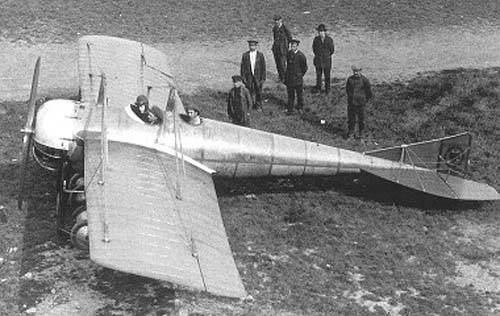
And Sikorsky's engineering thought continued to hit the key. He seriously thought about the creation of multi-engine air giants. And, having received the approval of the plant management and the board of the Russian-Baltic joint-stock company, in September, 1912 of the year began to implement its bold plans.
In February, 1913-th new aircraft, which the factory people, generous with all sorts of nicknames, dubbed "Grand" (that is, "big"), was ready and appeared before the public in all its glory. The dimensions and weight of the Granda were approximately twice as large as the world aircraft engineering technology. Its wingspan was 27 meters, take-off weight was about 4 tons. Four engine "Argus" on 100 l. with. each was located in tandem installations on the lower wing near the fuselage, in front of which there was an open balcony, followed by a closed glass cabin with a length of 5,75 and a height of 1,85 meter. In the cabin there are two seats for pilots, behind them there is a glass partition with a door to the passenger compartment, behind of which there was a washstand and a toilet (!).
On fine-tuning the giant took two months. 30 April “Grand” performed the first flight in a circle, 6 May - the second, finally proving its right to exist. Sikorsky turned to flying in the vicinity of St. Petersburg and above the city. The rumor about the air giant rolled through Russia. In Europe, they were surprised and did not believe. Emperor Nicholas II, who was in Krasnoe Selo, expressed a desire to take a look at the new “Russian miracle”. The plane was overtaken there, and 25 June, the sovereign, accompanied by the designer, boarded the airship. The court photographer captured Sikorsky and Nicholas II on the plane's balcony when a contented autocrat handed over a gold watch to the inventor.
The rumor states that it was then that the emperor expressed a wish to rename the aircraft: the Tsar was embarrassed by the foreign name of a completely Russian achievement. Like it or not, soon “Grand” (aka C-21) was christened “Russian Knight” and remained under this name in the history of world aviation.
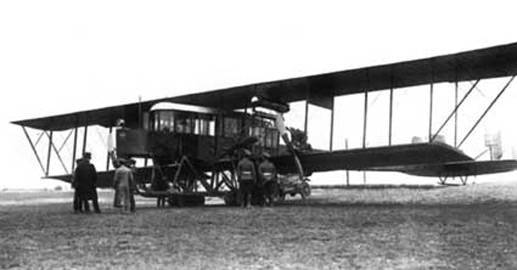
For the creation of the "Russian Knight", the State Duma issued Sikorsky 75 000 rubles. It was on this machine that Sikorsky performed the first blind flight — instrumentally, through a solid wall of rain — and set the world record for the duration of the flight — 1 h 54 minutes, having eight people on board.
The history of the “Russian Knight” ended quite curiously: in late August, a jet that had been tested and crashed into pieces directly above the airfield of a fighter crashed from an enormous height onto a plane pulled out of a hangar. After examining the damage, Igor Ivanovich decided not to restore the air giant, but to create a new, more perfect one. The Russian-Baltic Joint-Stock Company and the Military Ministry of Russia supported the designer. Thus, “Russian Knight” - the subject of national pride - became the ancestor of a whole class of heavy multi-motor aircrafts built in 1913 – 1917 and became known under the general name “Ilya Muromets” (aka С-22).
The first one was assembled and took to the sky in December 1913 of the year. And already on February 12, 1914-st set its first world record: it took off, having a man and an airfield dog named Shkalik on board the 16. The latter, of course, was not taken into account by the commission. But even without it, the payload lifted by “Muromts” was 1290 kg, which was an outstanding achievement.
In April, the second Ilya flew into the air. By this time, his “elder brother” was transformed by Sikorsky into a seaplane at the insistence of the naval department and remained the largest amphibian aircraft in the world until 1917. And on the second “Muromts” Igor Ivanovich, having taken on board members of the State Duma, 4 June 1914 of the year rose to a height of 2000 meters. As a result, not only was the new world record set, but approval was received for the manufacture of ten aircraft and their adoption by the Russian army as a heavy bomber.
To finally convince everyone of the extraordinary capabilities of the machine, Sikorsky with his team 16 June made a flight from St. Petersburg to Kiev and back. Although he established a number of world achievements, proved the advantages of multi-engine ships on long flights, opened the road to transport aviation, acquired the most valuable experience in instrument flight, this outstanding event didn’t receive a proper assessment: the World War I that began soon overshadowed everything else ...
During the war years, Sikorsky created the C-13 and C-14 single-seat fighters, the C-15 two-seat float light bomber, designed for naval aviation, the world's first high-speed interceptor C-16 fighter (the then young aircraft designer and in the near future, the “king of fighters” N. N. Polikarpov), a double reconnaissance aircraft C-17, a prototype of the C-19 attack aircraft and an escort fighter C-18, which was equipped with two course machine guns synchronized with a propeller Dénia fire in the rear hemisphere.
And, of course, the whole air armada of heavy bombers "Ilya Muromets", which became, probably, the favorite child of Igor Ivanovich.
By the way, already at the beginning of the war, Igor Ivanovich first suggested the possibility of using "Ilya" for disembarking "small but well-trained groups of volunteer hunters in the deep rear of the enemy", that is, the use of aviation to drop airborne and sabotage units. Alas, the idea did not receive support from the military.
But as a bomber, taking on board up to 500 kg of bombs, "Ilya Muromets" proved to be fully. It was under the direction of Sikorsky that the first cabinets-cassettes for salvo bomb dropping, electrical spreaders and bombing sights were developed and installed. It was he who for the first time placed photographic equipment on the bombers to record the results of the raid and planned aerial photography. It was Sikorsky who first began to “book” the most vulnerable parts of the aircraft - closing the cockpit and gas tanks with metal sheets. He was the first to put nose and tail articulated machine-gun systems on his bombers, turning the “Muromtsev” into “flying fortresses”. For the first time, this term was applied specifically to Russian bombers. And it is not by chance: for all the time of the war from 75 “Muromtsev”, only one (!) German fighter was shot down, three were shot down, but they all reached out to their territory. Aerial arrows of Russian heavy bombers drove into the ground eleven German and Austrian aircraft.
Connecting the continents
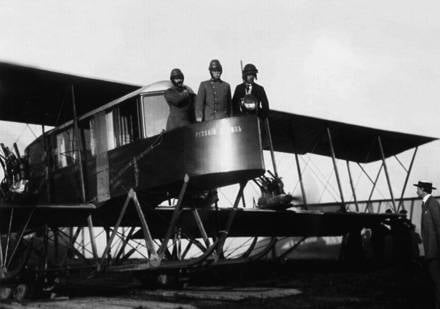
30 March 1919, Igor Ivanovich Sikorsky, who by his will became an emigre, set foot on the land of America. Began a new stage of life. Although there were only a few hundred dollars in my pocket, the future was painted in iridescent colors: after all, in the USA people with a lively mind and ideas were always valued, and he had a lot of them! However, it was not so easy. There was no work, the aviation industry collapsed, planes and engines were sold at bargain prices. Military orders were not given, but transport aviation practically did not exist - the time for mastering the vast expanses of the country had not yet come.
In the summer, Sikorsky attempted to create an aviation company, but it immediately failed. From despair, the designer took on any work, gave lessons on arithmetic, algebra, geometry, read lectures on astronomy and the development of aviation in immigrant clubs. And incredible projects about flights across the Atlantic and the Pacific continued to be born in his head. And fate again smiled genius.
5 in March 1923 was established in Rooseveltfield on Long Island by a company with the very loud name Sikorsky Aeroengineering Corporation, the number of shareholders was growing rapidly. Among them was even the famous Russian composer Sergey Rakhmaninov, who acquired thousands of dollars worth of shares on 5 and agreed (as an advertisement of the company) to take the position of vice-president of the company.
The first aircraft built by Igor Ivanovich in America was the passenger S-29 A, which was easily converted into a cargo one. The first flight was made by him 24 September 1924, and marked the return of the designer in the aircraft.
After the construction of the S-29 A, Sikorsky made several structurally interesting machines that attracted attention with simplicity, reliability, and high performance.
Especially for gaining experience in the development of amphibious aircraft was created a six-seater S-34. The S-35 was designed by Sikorsky on the order of the French First World War master René Fonck, who intended to fly across the Atlantic. But due to the mistake of the pilot, the car crashed right at the start of the record attempt, burying half of the crew under its rubble. For the designer, the black stripe began again, but he did not give up.
In the following years, the S-36, S-37 and S-38 family of "American Sikorski" added to the family. The latter, after testing in 1928, was recognized as the best car of its class in the world and soon began to fly not only in the USA, but also in Canada, Central and South America, Hawaii, and Africa.
In the late autumn of 1931, three S-40 began to ply the sky over the Caribbean Sea, making regular flights to Cuba and Bermuda. And in 1934, they were replaced by the legendary S-42, capable of covering a distance of 4000 kilometers. Passenger trans-Atlantic flights have become a reality. It was S-42 that made the first flights on San Francisco – Honolulu and San Francisco – New Zealand routes, and in 1937, it connected North America with Portugal and England.
In April, 1939, the management of the United Aircraft Corporation, decided to merge its branch, the aircraft design company Sikorsky, with the company Vout. Igor Ivanovich was prepared for the unenviable role of a modest subcontractor, a performer of someone else's will, other people's creative ideas. Naturally, this situation did not suit him. This was understood by friends and the immediate environment of the designer, but no one saw a way out of this situation.
No one but Sikorsky himself, who already knew what he would do next ...
And again helicopters
ALL THESE years Igor Ivanovich did not abandon the idea of building a helicopter. He constantly followed the development of this type of aircraft, along with the closest employees, was slowly engaged in helicopter-related topics, and from 1929, he conducted his own research and patented ideas. Back in 1930, the designer proposed that the United Aircraft Board take up the task of creating a rotorcraft, but this proposal was not supported. And he, on his own initiative, at his own peril and risk, continued research on this “impossible, unreliable, awkward, and awkward” aircraft, being sure that he would soon be able to create workable samples.
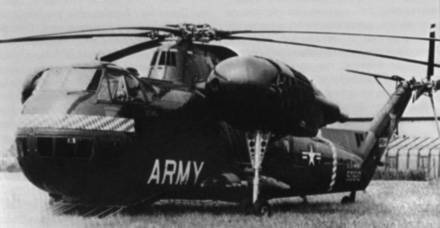
The first experimental Sikorsky VS-300 helicopter took off under the control of 14 September 1939, and the first public demonstration of the 20 on May 1940 in Bridgeport. After two years of intense testing, an experienced S-1942 two-seater (R-47) helicopter was created in 4, which soon entered mass production. It became the only helicopter of the countries of the anti-Hitler coalition used on the fronts of the Second World War.
Baptism of Sikorsky helicopters received in the spring 1944 of the year in Burma, where the Anglo-Indian troops were heavy fighting with the Japanese. To supply the units that were often fighting in the deep rear of the Japanese troops, the removal of the wounded and the crews of the downed aircraft required aircraft capable of taking off and landing on limited sites. Initially, light-engine small aircraft were used for this. However, in some places, even they could not get. In addition, helicopters were used for communications, reconnaissance, artillery fire adjustments, especially manifesting themselves during the battle for Imphal surrounded by the Japanese, when the supply of the besieged garrison was carried out by air for several months.
After the war, the shares of the Sikorsky company went uphill again. The management of United Aircraft restored the independence of Sikorsky Aircraft, which soon received a new production base of its own.
Over time, more advanced light Sikorsky helicopters appeared. Particularly great success fell to the share of the post-war S-51. It was widely used in many states for both military and civilian purposes, withstood intense competition with aircraft of other helicopter-building firms. This helicopter was especially notable in rescue operations. This was the purpose Sikorsky considered the main one for the helicopter. The next model, the lightweight S-52, was the first helicopter in the world to complete aerobatic maneuvers.
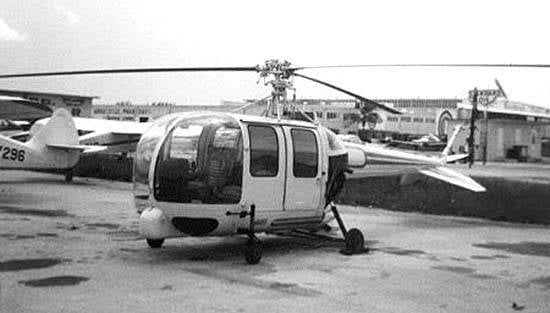
And yet, as in aircraft construction, Igor Ivanovich was most successful in the field of building heavy machines. Here he was not equal. Brilliantly changing the layout, Sikorsky created an unusually successful for its time transport helicopters. It was the largest, lifting and high-speed helicopter of its time.
The best helicopter, created by Sikorsky, took off in the 1954 year. It was S-58. It was built by a number of countries, and many of its copies have been exploited to date. In terms of its technical and economic characteristics, it surpassed all the helicopters of its time and became the “swan song” of the great aircraft designer.

In the 1958 year, when the serial production of the S-58 reached its peak - 400 machines per year - Igor Ivanovich retired, retaining the position of advisor to the company ...
An outstanding inventor, a brilliant engineer, a brave test-pilot, an outstanding in all respects people left this world on October 26 on 1972, finding peace in the cemetery of the town of Easton in Connecticut.
Looking to the sky
“WE NEED to work, and most importantly, to learn what will help us restore our homeland when it will require it from us,” said Sikorsky, speaking to compatriots-emigrants.
Throughout his life, he remained a patriot of Russia, did a lot for propaganda in America of the achievements of Russian culture and science, without fail remaining a board member of the Tolstoy Foundation and the Society of Russian Culture. Many gave lectures and reports, and not necessarily on aviation topics. Being a deeply religious man, he contributed in every way to the development of the Russian Orthodox Church in the USA, supported it not only materially. Sikorsky wrote a number of books and brochures - “Invisible Meeting,” “Evolution of the Soul,” “In Search of Higher Realities,” and others, attributed by specialists to the most original works of Russian foreign theological thought.
During his life, Sikorsky received over 80 various honorary awards, prizes and diplomas. Among them are the Russian Order of St. Vladimir IV degree, medals of David Guggenheim, James Watt, diploma of the National Gallery of Glory of Inventors. In 1948, he received a rare award - the Wright Brothers Memorial Prize, and in 1967 he was awarded the John Fritz Medal of Honor for scientific and technical achievements in the field of basic and applied sciences. In aviation, besides him, it was awarded only Orvil Wright.
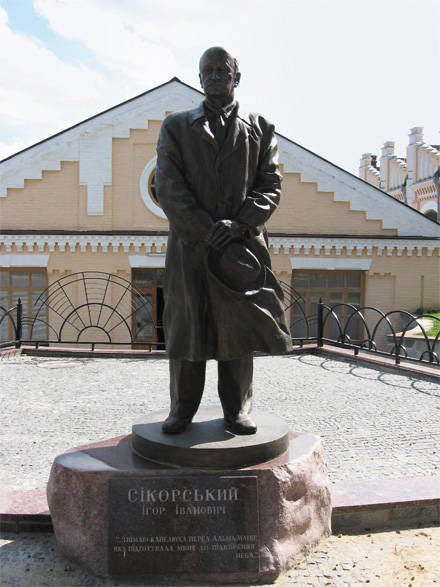
Nevertheless, the main award of the great aircraft designer is the gratitude of people widely using the machines he created.
By the way, starting with Dwight Eisenhower, all the first persons of the American state fly by helicopters with the inscription "Sikorsky". And the first persons of the Russian state could fly ...
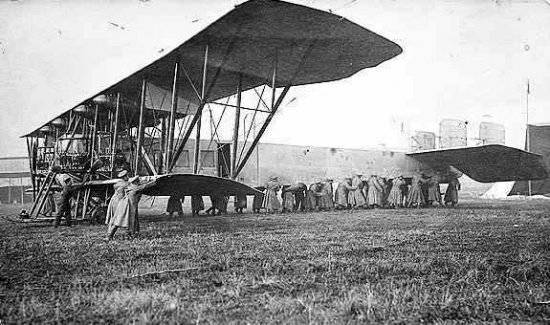
Information